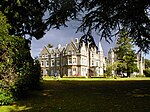Church of Our Lady of the Assumption, Englefield Green
1931 establishments in England20th-century Roman Catholic church buildings in the United KingdomEngvarB from September 2019Roman Catholic churches completed in 1931Roman Catholic churches in Surrey ... and 1 more
Romanesque Revival church buildings in England

The Church of Our Lady of the Assumption is a Roman Catholic church in Englefield Green, Surrey. It is situated on St Cuthbert's Close and faces Harvest Road in the older side of the village close to Egham Hill. It was built from 1930 to 1931 and designed by Joseph Goldie. Although the church is not a listed building, English Heritage, in two separate reports, stated "this is a thumping great church" and "many churches were being built in the Romanesque style in the 1930s ... but Goldie's church is better composed and more competently detailed than most."
Excerpt from the Wikipedia article Church of Our Lady of the Assumption, Englefield Green (License: CC BY-SA 3.0, Authors, Images).Church of Our Lady of the Assumption, Englefield Green
St. Cuthbert's Close, Borough of Runnymede
Geographical coordinates (GPS) Address External links Nearby Places Show on map
Geographical coordinates (GPS)
| Latitude | Longitude |
|---|---|
| N 51.428866 ° | E -0.566813 ° |
Address
Catholic Church of the Assumption of Our Lady
St. Cuthbert's Close
TW20 0QR Borough of Runnymede
England, United Kingdom
Open on Google Maps








